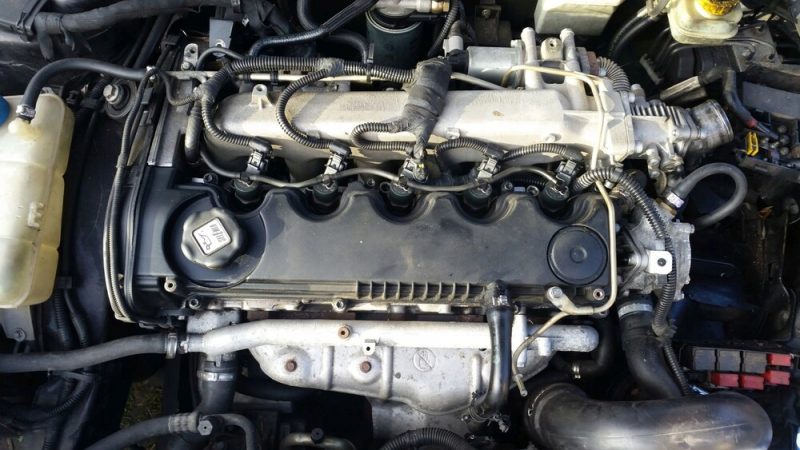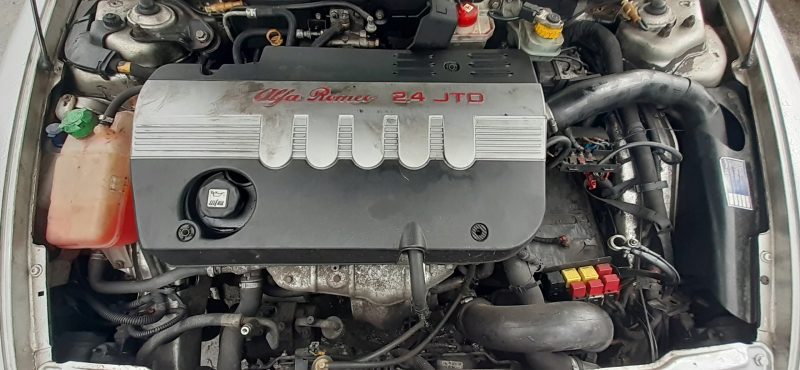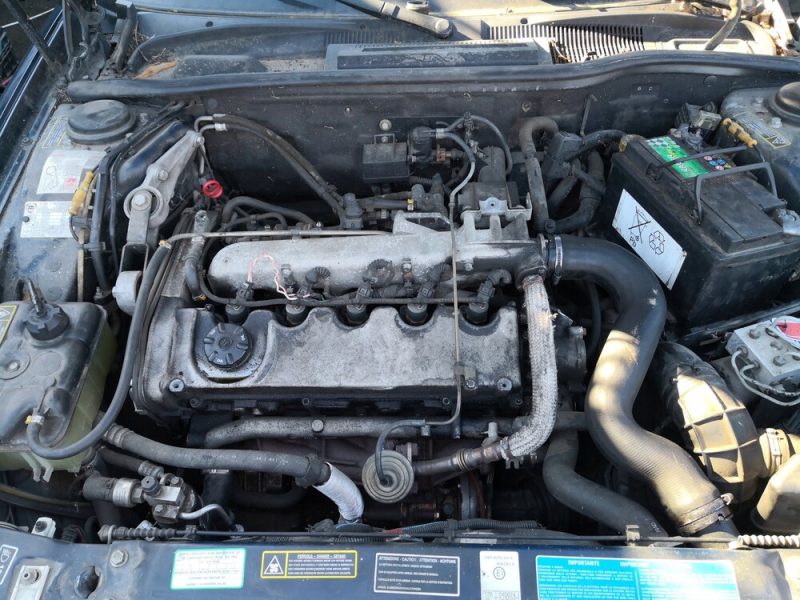Alfa Romeo cars were the first to use diesel engines equipped with the Common Rail system. It happened in 1997, when two diesel engines were produced: one was a four-cylinder engine with a capacity of 1.9 liters, and the second was a five-cylinder engine with a capacity of 2.4 liters.
Power units for 1.9 liters were equipped not only with cars Alfa Romeo, but the diesel engine for 2.4 liters was put exclusively on cars of this manufacturer. For example, it was equipped with Alfa Romeo 156 and 166, Fiat Marea, as well as Lancha: Kappa, Libra and Thesis. Already in 2004, the power unit was improved. In particular, it became more powerful, there was a 20-valve cylinder head, and in addition, the engine was improved to meet Euro-4 standards.
The usual belt is used in the timing drive, but besides the camshaft, it also drives the pump. There are no hydrocompensators, as well as rockers. The mechanism is simplified, the cams press directly on the tappets.
In the crankcase of the power unit under consideration, an oil pump with a chain drive is installed, and from the pinion shaft there is a balancer shaft.
The 2.4 JTD power unit received a Boshevskiy oil pump, this is the first generation with Common Rail.
Ten-valve internal combustion engines Alfa Romeo seriously differ from each other with ECU firmware. EGR systems are also different, because over time in the European Union seriously changed the environmental requirements. There are significant changes and in turbines.
What about the reliability of the motor Alfa Romeo?
Italian engineers have got a very good motor: resourceful and reliable. If you treat the car with care, the power unit will serve 500 thousand and more.
Serious problems can be faced only in case of careless operation of these capricious cars. The motor can stop starting due to a variety of external problems, for example:
- Immobilizer failure;
- Burned wiring;
- Transmission timing problems (e.g., when synchronization between the crankshaft and camshaft sensors is lost).

If you try to start the engine for a long period of time with a push start, the key may break, causing the pistons and valves to collide, and nothing good will come of it. Trust our experience, these motors are most often killed by lack of proper and timely maintenance.
Fuel level indicator and priming pump
One of the most rare failures that causes the powertrain to stop starting is the failure of the priming pump. This fault, as well as a number of others, is detected exclusively with the help of diagnostic software. When the pump stops pumping, there is no pressure in the ramp. The malfunction can be detected by measuring the pressure. The minimum level is 3.6 bar.
The pressure in the ramp or supply line (depending on where you check) can be zero, but this happens when the tank is completely empty. And yes, you’d be surprised, but it does happen. The problem is that the fuel level sensor often glitches and gives incorrect information about the fuel. Thus, the motorist, trusting these readings, easily empties the tank, and thinks that the problem is not in the fuel. Of course, no one will be able to start the power unit in such a state.
It is worth saying at once that with careful attitude and timely maintenance, you can avoid problems with the fuel injector, pressure regulator and injectors. They are of high quality and rarely fail.
Fuel filter
Immediately prepare for the fact that you will have to change the filter after 10 thousand. And you should buy only original or high-quality substitutes. The problem is that cheap Chinese analogs quickly delaminate, after which they begin to clog the entire fuel system with scraps of paper. The pressure regulator is also clogged.
Oil leakage
In principle, the motor rarely leaks, but there are still a couple of places where sweat can appear. First of all – the valve cover, which is made of plastic, the oil seal of the crankshaft and camshaft, as well as the plug of the balancer shaft.
Belt Squeak
Periodically, motorists are faced with a strong belt squeal. To be precise, the nasty sound is produced by the tensioner roller. The problem is that it is wedged, and if the problem is started, it skews. This leads to rapid wear of the belt, there were cases when it even tore. So, if you hear a squeak – it’s time to replace the roller.
EGR valve
The first versions of the considered power unit, which was produced taking into account the requirements of Euro-2, had vacuum control of the valve. But when the requirements of Euro-3 were introduced, the system had to be redesigned for solenoid control. In general, this situation is observed with the vast majority of diesel engines.

Functioning of the valve is tied to the DMRV data. According to the information from the sensor, the ECU makes a decision on recirculation.
In the inlet often accumulates soot, and this is the main cause of the EGR valve wedge. The symptoms are as follows:
- The car does not start from the first time.
- Loss of power.
- There are jerks during acceleration.
- In addition, problems with the operation of the EGR valve can appear due to problems with the DMRV.
Pistons
Both versions of the power unit (1.9 liters and 2.4 liters), have identical injectors by Bosch. Problems with them appear exclusively on cars with impressive mileage (300 thousand and more). The most common problem is that the injectors drain too much diesel into the return. If they do it synchronously, there are difficulties in starting the motor, because the pressure grows very slowly, and it is not enough to start the engine from the first time.
But when not all injectors drain strongly, the motor begins to work with perceptible vibrations. In any case, if you feel a strong vibration at idle – it means that it’s time to change the injectors.
Extremely rare, but it still happens, due to wear, the atomizer can flood the piston, which will lead to its destruction.
Regulator
The fuel ramp of the Alfa Romeo diesel engine is not equipped with a regulator and diesel dump line. There is just one regulator in the engine, located on the fuel injector. It is responsible for maintaining pressure by adjusting the diesel feed to the fuel injector. This valve only opens when you try to start the engine, the rest of the time it is closed. If it becomes clogged, it will stop bleeding fuel, resulting in excessive pressure in the frame. It is easy to realize this by the pressure sensor. Also, in case of excess, the control unit will automatically shut off the engine. This is a built-in emergency option.
TNVD
The Boshevskiy fuel injector is very rarely a cause for headaches, mainly because of its quality and colossal service life. But if somehow it does wear out, the engine starts to start with difficulty on cold, even at low frosts.
The timing belt
As in the situation with the injectors, both varieties of the motor have the same belt, which includes a belt and two rollers. Alfa Romeo engineers recommend to replace the belt once in 120 thousand, but our experience suggests that it should be done after 50-60 thousand. Belt replacement is very simple, you don’t even need to fix the shafts.

While changing the belt, pay attention to the pump, because it often jams, and sometimes it is skewed, and this leads to belt wear. The higher its wear, the more likely it is to break. It can also slip if the belt breaks if there is an attachment belt failure.
Turbine
The engine in question has a Garrett turbine with variable geometry. Initial versions of the motor, which came out taking into account the environmental requirements of Euro-2, had a turbine with automatic control. The geometry blades were driven from the pressure injected in the compressor.
More modern motors that came out in the Euro-3 era also have a Garret turbine, but with an electro-vacuum valve.
To be fair, both variations are characterized by high quality and performance, but here much depends on the oil used. Most often, Garret turbines die due to classic oil starvation. Therefore, it is not worth saving on it.
With critical wear of the turbine, there is a backlash of the shaft, so it begins to drive oil into the inlet, and this is the main cause of hydrostroke. Simply put, excessive amounts of oil will start flowing into the internal combustion engine. It is easy to realize this by too white or blue smoke from the exhaust pipe.
But most of the problems with the turbine are caused by the lack of tightness of the pipes. They are very often cracked and through these micro cracks the boost pressure starts to escape.
Oil pump chain
With a solid kilometerage (over 300 thousand), the chain on the power unit will begin to stretch. This can be recognized by a loud rustling. In neglected cases, it starts to rattle. The chain breaks rarely, because the malfunction is easy to trace and replace the chain. So experienced owners do not bring their car to such a situation.
The repair kit includes not only the chain, but also stars and shoes. But it is not easy to find such a set, and the price bites (about 300 dollars). Therefore, it is much easier to find a used chain.
Some experienced motorists who change the chain, often remove the balancer shaft. Most likely, this happens because of the popular opinion that the balancer is superfluous. But it is still worth recognizing that extremely rarely, but the source of the unpleasant sound is exactly the shaft, but not the chain. This is due to the wear of the supports.
